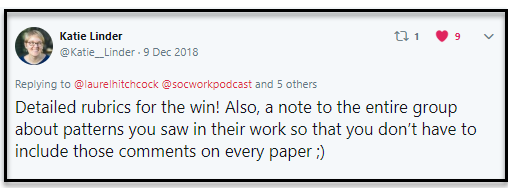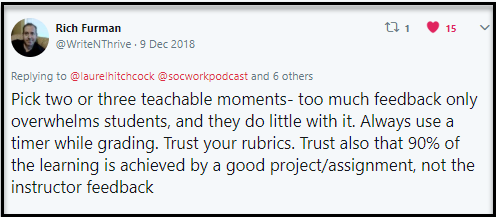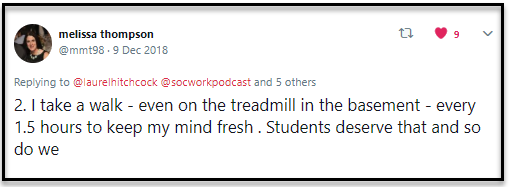Changing my grading practices in 2019: Tips for #SocWorkEd
At the end of last semester, I was grouchy about grading. If I am going to be truthful, I am always grouchy about grading. Don’t get me wrong; I love reviewing student work and offering feedback about their growth as a social work professional. What makes me grouchy about grading is that I don’t have a solid process for providing quality feedback in an efficient way. Every semester I find myself spending a lot of time typing comments and not really sure students are looking at anything but the grade. I keep up with grading comments in a word document and I use rubrics, and grading still feels overwhelming. So I decided to reach out to my professional network on Twitter for their suggestions and ideas.
I sent this tweet on December 9th:
And my colleagues did not disappoint; sharing some great ideas from using autotext software to employing self-care strategies. I captured their responses in a Twitter Moment and selected a few to try this semester. I am going to outline their ideas in this blog post, and try them out this semester, reporting back at the end of the semester about what worked and didn’t work for me.
Rubrics and Grading Comments
Dr. Katie Linder of Oregon State University and Kristen Samuels of the University of Phoenix recommended a detailed rubric with is available to students from the first day of class.
I use rubrics, usually building them in our learning management system (Canvas) or in a word document along with the assignment. I wish it wasn’t true, but not all of my rubrics are available the first day of class and some need more detail. To improve my use of rubrics this semester, I am going to review rubrics from colleagues and other sources to help with the improving details in my rubrics. One good source for rubrics is the Association of American Colleges and Universities’ Value Rubrics, which are free and cover a variety of learning outcomes from critical thinking to self-reflection. I’ll be looking for other examples so feel free to share your rubrics. Katie also recommended offering a group note the entire class about patterns that I saw in their work. This would serve two purposes. One, I wouldn’t have to include those comments in my feedback to each student, and two, I think students would be more likely to review a note sent out to the entire class.
For a twist on this practice, I will use Lori Mumpower’s (she’s at Embry-Riddle Aeronautical University) suggestion to provide audio comments, which she says saves the her a lot of time. There is also some research to suggest that students have more positive responses to audio feedback compared to written comments.
There are two resources I will use to help me learn how to provide quality audio feedback. One is a great resource from the Digital Education Research Group at Monash University on technology mediated assessment feedback. In their free resources, they provide how-to information for various audio and video software as well as template for providing feedback to students via audio or video. This semester, I plan to use their template to structure both video and audio feedback to my students. The second resource is Flipgrid, a web-based video discussion platfrom. My colleague Todd Sage of the University at Buffalo has been using Flipgrid for over a year now, and you can read about how he uses the free software in his blog post from last year – Incorporating Flipgrid into the Social Work Classroom: Tips for #SocWorkEd.
Dr. Andrew Battista at New York University recommended using a text expander program or web-browser add-on to streamline the process of typing grading comments into a text box or in word document.
These programs allow a user to capture text for later retrieval through shortcuts on keyboard. Some programs already come with built in comments for APA Style such as GradeAssist, recommended by Dr. Melanie Sage also at the University at Buffalo. After a quick online review of these programs, I decided the learning curve was too high for me to implement immediately and the cost associated with some of the programs required a more in-depth review. Maybe I’ll try these next semester.
A list of Common Writing Mistakes
Karen Zgoda, one of the founders of online #MacroSW community, suggested using hyperlinks to share information about common writing errors when giving feedback to students. She has a good list on her blog – Most Common Student Writing Mistakes and How to Fix Them. I already had a series of handouts about common writing mistakes that I share with students as needed. I do this by uploading the worksheet into the grading comments section for each student when I grade in our learning management system, Canvas. Inspired by Karen’s idea, I created a centralized resource (a web page in Canvas) with all of these handouts as well as some additional links to writing resources. I numbered each writing topic and provided directions for students to refer to the appropriate topic based on the numbers. I will then list the numbers in their individualized grading comments. Fingers crossed that this process will save time with grading!
Before creating this resource, I did check with our campus writing center to see if they had a list of common errors already available online. No such luck so I will be advocating for our center to create one.
Creating intentional grading practices
Perhaps the most helpful suggestion for improving my grading practices focused on developing more intentional practices for the process. Dr. Rich Furman of the University of Washington Tacoma advised trusting that most of the student learning occurs with the assignment, not the instructor’s feedback.
To that end, he recommends setting time limits for your grading sessions by using a timer. This reminds me of Parkinson’s Law – work expands to fill the time available for its completion – which means if you give yourself a week to grade a class assignment, it will take you a week to do it even if it is really a four hour job. Rich also suggests picking two or three points (teachable moments) from the assignment to focus on in your feedback, noting that too much feedback can be overwhelming for students. Melissa Thompson at Dominican University suggests dividing up the work based on easy of grading, by alternating between assignments that require my detailed attention and those that do not. Finally, Melissa reminded me about the importance of self-care when grading by taking breaks to stretch or walk around.
As I already said, I’ll be trying all of these practices with this coming semester’s grading and plan to report back in April when my semester is over. I would be very curious to hear from others about how they approach grading or if they want to try any of these practices with me over the next few months. Please leave a comment below or tweet me at @laurelhitchcock.
How to cite this post:
Hitchcock, L. (2019, January 11). Changing my grading practices in 2019: Tips for #SocWorkEd [Blog Posts]. Retrieved from: https://laureliversonhitchcock.org/2019/01/11/changing-my-grading-practices-in-2019-tips-for-socworked/









January 11, 2019
Great post, Laurel! Love all of the resources in this one. I am using Flipgrid this semester after seeing and hearing about Todd’s work with it!
January 14, 2019
Thanks, Tom! I just finished my first week with Flipgrid and loved how easy it was to use, from set-up to recording my own videos. How do you plan to grade with Flipgrid?
January 11, 2019
Great ideas. I do have a basic issue with rubrics, though. If the rubric is specific enough to be helpful, it seems to remove critical thinking from the process. It becomes a matter of students just doing what they are told in even greater detail. So, rubrics can be helpful when you are assessing what I call “procedural knowledge” or factual knowledge where there’s a clear right and wrong answer. But I don’t know what to do when I am asking students to make choices and use their own judgement. How do you deal with this concern?
January 14, 2019
Hello Sam, I highly recommend that you take a look at the Value Rubrics from the Association of American Colleges & Universities: https://www.aacu.org/value-rubrics. These rubrics address learning for intellectual skills such as critical thinking and problem solving to ethical reasoning and integrative learning. I use these rubrics as a model when building my own assessment tools. Take a look and let me know what you think.
January 11, 2019
I love these ideas, use some of them already, but from reading have come to realize I am doing maybe too many at once.
Something I do to enhance learning while reducing workload is to have some assignments critically reviewed by other students, or groups will assess other groups, assignments through rubrics and specific feedback.
January 14, 2019
Ellen, your suggestion to have students critically review an assignment is a great! What do you ask them to do? I imagine this as a good extra credit assignment for my courses.